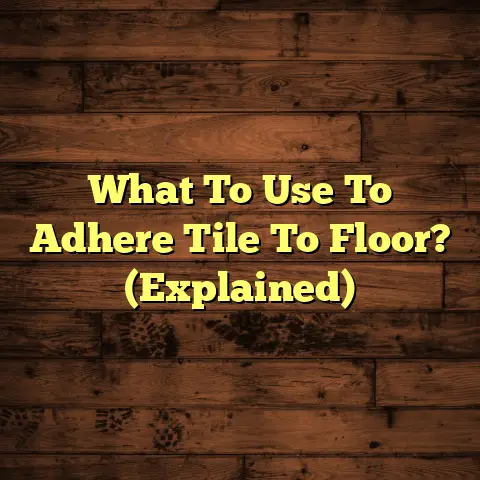How To Get Crayon Off Vinyl Floor? (2 Methods Now!)
Let’s paint a picture, shall we?
Imagine a cozy living room, sunlight streaming through the windows, illuminating children’s artwork proudly displayed on the walls.
Laughter fills the air as your kids are completely engrossed in their art projects, crayons scattered across the dining table.
It’s a beautiful, vibrant scene, right?
But then, the inevitable happens.
A rogue crayon, usually the brightest red or deepest blue, ends up making its mark… on your beautiful vinyl floor.
Ugh! I know the feeling.
As a flooring contractor with over 15 years of experience, I’ve seen this scenario play out more times than I can count.
It’s frustrating, I get it.
You want a clean, welcoming home, but sometimes life (and little artists) throws you a curveball.
Don’t worry, though!
Getting crayon off vinyl flooring is totally achievable.
And that’s exactly what I’m here to guide you through.
Let’s dive in!
Section 1: Understanding Vinyl Flooring
Vinyl flooring has become incredibly popular in modern homes, and for good reason!
It’s durable, affordable, and relatively easy to maintain.
In fact, according to a report by Grand View Research, the global vinyl flooring market was valued at USD 37.94 billion in 2022 and is expected to grow.
That’s a lot of vinyl!
But, despite its resilience, vinyl isn’t completely immune to the trials and tribulations of everyday life.
Marks and stains, especially from substances like crayons, can be a real pain.
The key is to act quickly!
The longer the crayon sits, the harder it becomes to remove without potentially damaging the vinyl.
Think of it like this: the vinyl is porous at a microscopic level.
The longer the crayon’s wax sits there, the more it seeps into those tiny pores, making it harder to lift it out.
Section 2: The Nature of Crayon Stains
So, what makes crayon stains so stubborn?
Well, it all comes down to their composition.
Crayons are essentially made of wax, pigment, and a binder.
The wax is what allows the crayon to glide smoothly across the paper (or your floor!), but it’s also what causes it to stick to surfaces.
When a crayon rubs against vinyl, the wax transfers onto the flooring, leaving behind a residue that can be difficult to remove.
Certain colors, like red, blue, and green, tend to be more problematic.
This is often because they contain more concentrated pigments that can leave a more noticeable stain.
I’ve personally found that darker shades are always the toughest.
Think about it: a light yellow crayon mark is going to be much less visible (and easier to remove) than a deep purple one.
Section 3: Preparing for the Cleaning Process
Okay, before we jump into the cleaning methods, let’s make sure you have everything you need.
Having the right tools and supplies on hand will make the process much smoother and more efficient.
Here’s a list of essentials:
- Soft cloths or sponges: Microfiber cloths are my go-to. They’re gentle on vinyl and won’t scratch the surface.
- Warm water: For rinsing and diluting cleaning solutions.
- Dish soap: A mild dish soap, like Dawn, is great for breaking down waxy residues.
- Baking soda: A natural abrasive that can help lift stains.
- White vinegar: A mild acid that can dissolve crayon wax.
- Spray bottle: For applying cleaning solutions evenly.
- Clean towels: For drying the floor after cleaning.
- A soft-bristled brush (optional): For scrubbing tougher stains.
Important Safety Tip:
Before you start slathering any cleaning solution all over your floor, always test it on a small, inconspicuous area first!
This is absolutely crucial!
You want to make sure the solution doesn’t discolor or damage the vinyl.
Pick a spot in a closet or under a piece of furniture where any potential damage won’t be visible.
Apply a small amount of the cleaning solution, let it sit for a few minutes, and then wipe it away.
If you don’t see any adverse effects after 24 hours, you’re good to go!
Section 4: Method 1 – The Baking Soda Paste Approach
Alright, let’s get down to business!
The first method I recommend is using a baking soda paste.
This is a great option for fresh crayon marks and is a relatively gentle approach.
Here’s how to do it:
Ingredients:
- Baking soda
- Water
Instructions:
- Create a paste: In a small bowl, mix baking soda with a small amount of water until you form a thick paste. The consistency should be similar to toothpaste.
- Apply the paste: Using your finger or a soft cloth, apply the paste directly onto the crayon stain, making sure to cover it completely.
- Let it sit: Allow the paste to sit for about 5-10 minutes. This gives the baking soda time to penetrate the crayon residue and start breaking it down.
- Gently scrub: With a soft cloth or sponge, gently scrub the area in circular motions. Avoid using too much pressure, as you don’t want to scratch the vinyl.
- Wipe clean: Use a damp cloth to wipe away the baking soda residue. You may need to rinse the cloth several times to remove all the paste.
- Dry the area: Finally, dry the area with a clean towel.
Tips for Success:
- If the stain is particularly stubborn, you can leave the baking soda paste on for a longer period of time, up to 30 minutes.
- For larger stains, work in small sections to ensure the baking soda paste doesn’t dry out before you have a chance to scrub it.
- If the stain persists after the first attempt, repeat the process. Sometimes it takes a couple of tries to fully remove the crayon mark.
I’ve seen this method work wonders, especially on newer vinyl floors.
The baking soda acts as a mild abrasive, gently lifting the crayon wax without damaging the surface.
Section 5: Method 2 – The Dish Soap and Vinegar Solution
If the baking soda paste doesn’t quite do the trick, or if you’re dealing with an older, more set-in stain, the dish soap and vinegar solution is your next best bet.
This combination is a bit more powerful, but still safe for most vinyl floors (remember that test patch!).
Here’s the recipe:
Ingredients:
- Dish soap (mild, like Dawn)
- White vinegar
- Warm water
Instructions:
- Mix the solution: In a spray bottle, mix one part dish soap, two parts white vinegar, and four parts warm water. For example, you could use 1/4 cup dish soap, 1/2 cup white vinegar, and 1 cup warm water.
- Spray the area: Spray the solution directly onto the crayon-stained area, making sure to saturate it well.
- Let it sit: Allow the solution to sit for 5-10 minutes to loosen the crayon residue.
- Scrub gently: Using a soft cloth, gently scrub the affected area until the crayon is removed. Again, avoid using excessive pressure.
- Rinse thoroughly: Rinse the area with clean water using another cloth to ensure all soap and vinegar are wiped away.
- Dry completely: Dry the surface thoroughly with a clean towel to prevent any water damage.
Why this Works:
The dish soap helps to break down the waxy residue of the crayon, while the vinegar acts as a mild solvent to dissolve it.
The warm water helps to activate both ingredients, making them more effective.
When to Choose this Method:
I usually recommend this method for tougher stains or when the baking soda paste hasn’t yielded the desired results.
It’s also a good option if you’re dealing with a larger area of crayon marks.
The spray bottle makes it easy to apply the solution evenly across the entire surface.
Section 6: Additional Tips and Tricks
Okay, you’ve conquered the crayon stain!
High five!
But let’s talk about preventing future mishaps and keeping your vinyl floors looking their best.
Here are a few extra tips and tricks:
- Regular cleaning: Establish a regular cleaning routine to prevent dirt and grime from building up on your vinyl floors. Sweep or vacuum regularly, and mop with a mild detergent solution.
- Protective measures: Place rugs or mats in high-traffic areas to protect your vinyl flooring from scratches and wear.
- Crayon boundaries: Designate a specific area for arts and crafts to help contain the mess. Use a tablecloth or placemats to protect surfaces.
- Involve the kids: Make cleaning up part of the fun! Involve your children in the cleaning process to teach them responsibility and care for their living space.
My Personal Experience:
I remember one time, my own daughter, when she was about 5, decided to redecorate our kitchen floor with a whole box of crayons.
It was… a disaster!
I tried the baking soda paste method first, but it wasn’t quite cutting it.
So, I switched to the dish soap and vinegar solution, and it worked like a charm!
I even turned it into a game with my daughter, making her my “official cleaning assistant.”
She loved it, and we got the floor sparkling clean in no time.
Conclusion
So, there you have it!
Two effective methods for getting crayon off your vinyl floor.
Remember, creativity and messes often go hand in hand.
Don’t let the fear of stains stifle your children’s artistic expression.
Embrace the cleaning process as a bonding opportunity, and teach your kids valuable life skills along the way.
With a little patience and the right techniques, you can keep your vinyl floors beautiful and clean, no matter what artistic adventures your family embarks on.
Now go forth and conquer those crayon stains!
You got this!





